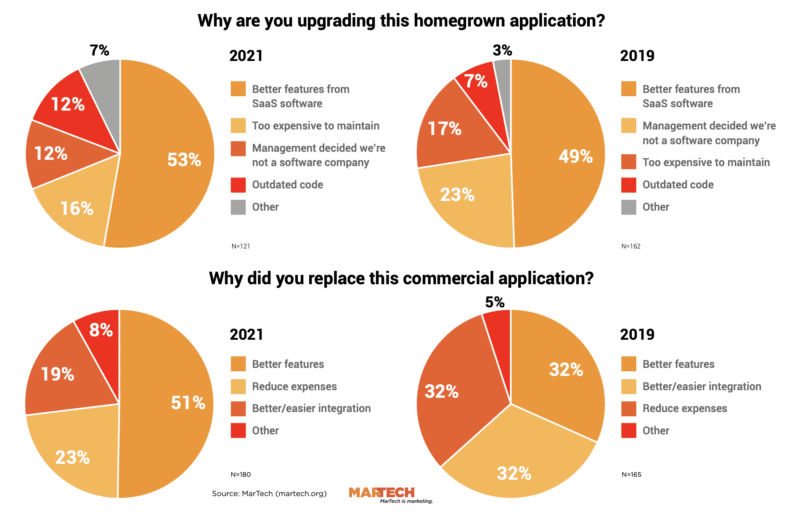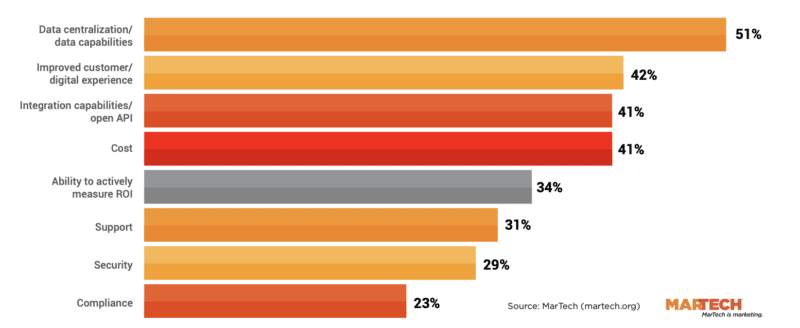In the 2019 MarTech Replacement Survey we saw a mix of homegrown, legacy solutions and commercial solutions being replaced. But in 2021 we saw a big shift. This year when we launched this survey to help us understand how the pandemic has affected marketing technology purchases, we found more than half the respondents reported moving from one commercial platform to another. On the other hand, around 30% did move from a commercial or an existing homegrown solution to another homegrown solution — so IT and DevOps teams that manage these platforms still have a role to play.
But at a time when budgets were tightened, it wasn’t primarily cost that drove these decisions. Whether homegrown or commercial applications were being replaced, features trumped cost. In each case, more than 50% said the replacement was driven by better features, although around 41% did cite cost as the reason for migrating solutions. Over 70% were replacing a solution that had been in place between one and five years. The peak period for replacement (3 to 5 years) remained the same as in our 2019 survey.
We drilled down further into the factors that meant most to the replacers. Because multiple choice answers were permitted, cost showed much more strongly. Clearly respondents were prepared to cite cost as important as well as more substantive features. For better or worse, compliance and security were somewhat down the list.

Marketers wanted better data capabilities
Significantly, beating cost were two closely associated factors: data centralization/data capabilities (number one at 51%) and being able to deliver an improved customer/digital experience (at second place at 42%). It’s hard to deliver the latter unless you’re on top of the former. Also, 41% cited integration capabilities/open API, because people don’t want to acquire new silos.
Related: Marketers moving away from home-grown tools, hiring fresh teams for new tech
It’s difficult to compare the factors motivating change in detail, as the 2019 question was not multiple choice, but it’s interesting to note that compliance was at number one (22%) — perhaps indicating that brands were still adjusting to GDPR.
In 2019, cost had ranked precisely alongside features and integration capabilities as the reason to replace commercial applications. It’s difficult to compare the factors motivating change in detail, as the 2019 question was not multiple choice, but it’s interesting to note that compliance was at number one (22%) — perhaps indicating that brands were still adjusting to GDPR.

Replacement case: Negotiating for price cuts
The marketing operations and sales teams at personal experience gifting platform Alyce were looking for data enrichment for B2B sales. Their platform focuses on delivering corporate gifts that grow B2B relationships, and in order to reach their own target, they needed to boost their business data with a new vendor.
“We were using enrichment primarily around industry and employee size,” said Kanako Tone, marketing operations manager at Alyce. “Employee size tends to be wrong, especially for companies below 1,000 employees. They tend to be different from what some public sources say.”
Alyce had been using ZoomInfo for business data, and they continue to use it for some data needs. For data enrichment, they considered LinkedIn Sales Insights and LinkedIn Sales Navigator. They also looked at another data enrichment vendor that quoted Alyce a significantly lower price than LinkedIn.
“We were about to go with the other vendor, but first we went back to the LinkedIn sales rep and they slashed their prices,” said Tone.
There were other features that were attractive to the B2B marketing and sales teams at Alyce. For instance, LinkedIn data enrichment includes the number of employees in a particular organization who are on the marketing team.
“For marketing teams that have 20 people versus those that have five, how we should target these teams is completely different,” Tone said. Ultimately, Alyce found the data to support their nuanced B2B strategy by encouraging the vendors to compete for lower pricing.
The post Though marketers wanted to save on cost, better features drove 2021 technology replacements appeared first on MarTech.


0 Comments